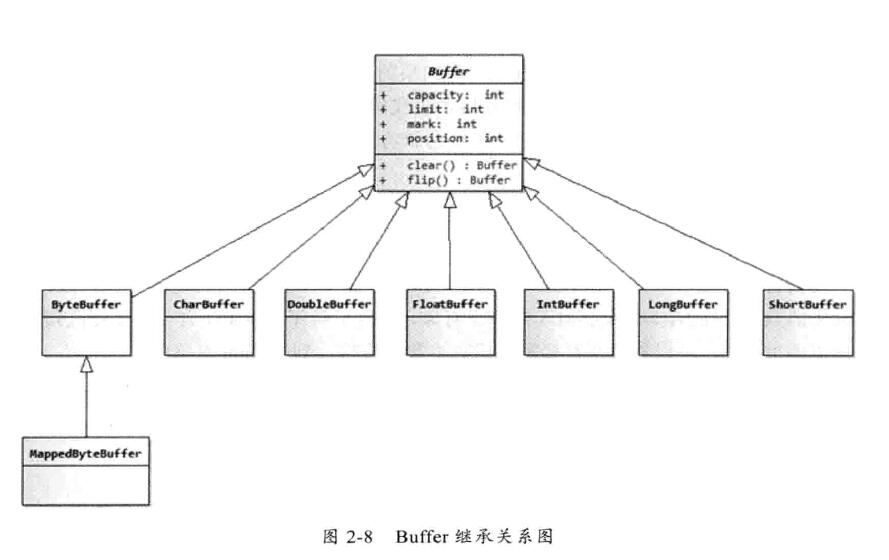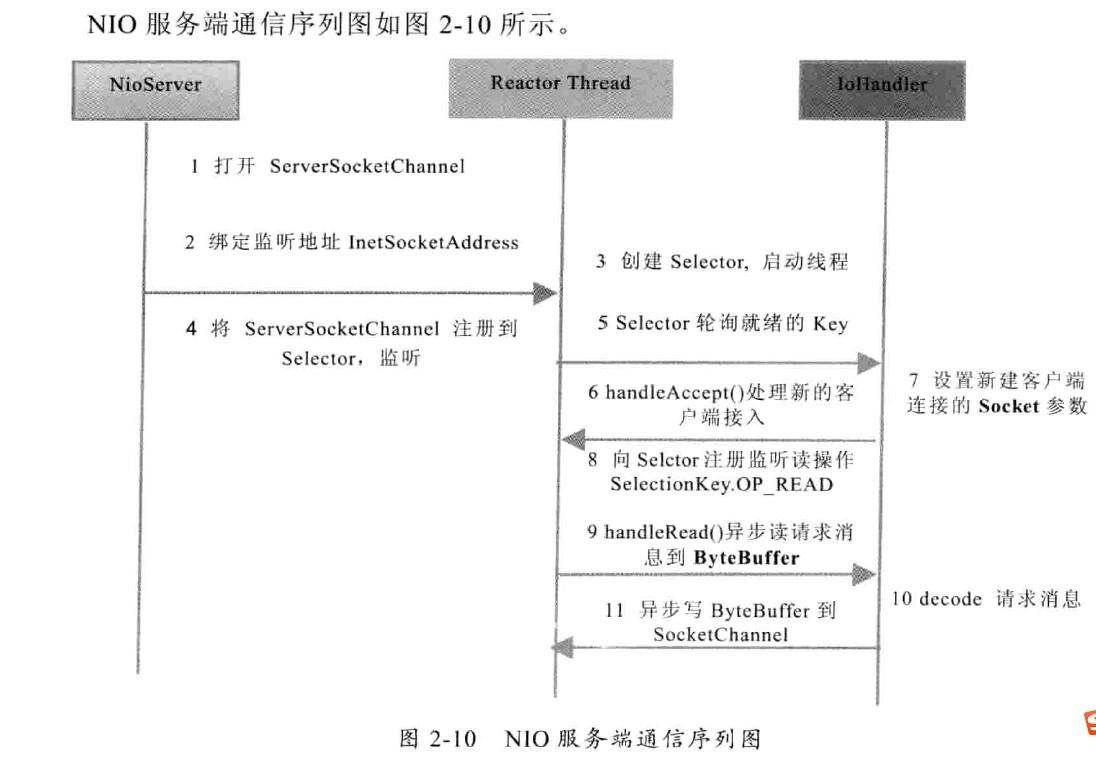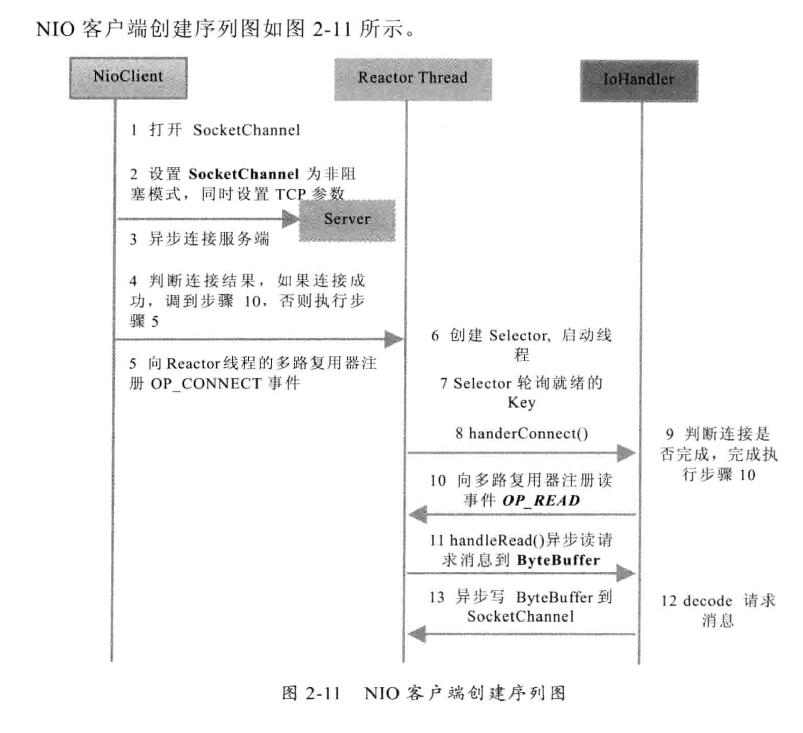NIO的基本概念
新的输入/输出(NIO)库是在JDK 1.4中引入的。NIO弥补了原来的I/O的不足,它在标准Java代码中提供了高速的、面向块的I/O。
原来的I/O库与NIO最重要的区别是数据打包和传输的方式的不同,原来的 I/O 以流 的方式处理数据,而 NIO 以块 的方式处理数据。
1.缓冲区:
Buffer是一个容器对象,它包含一些要写入或者刚读出的数据。在NIO中加入Buffer对象,体现了新库与原I/O的一个重要区别。在面向流的I/O中,您将数据直接写入或者将数据直接读到Stream对象中。
在NIO库中,所有数据都是用缓冲区处理的。在读取数据时,它是直接读到缓冲区中的。在写入数据时,它是写入到缓冲区中的。任何时候访问NIO中的数据,您都是将它放到缓冲区中。
缓冲区实质上是一个数组。通常它是一个字节数组,但是也可以使用其他种类的数组。但是一个缓冲区不仅仅是一个数组。缓冲区提供了对数据的结构化访问,而且还可以跟踪系统的读/写进程。
最常用的缓冲区类型是ByteBuffer。 一个ByteBuffer可以在其底层字节数组上进行get/set操作(即字节的获取和设置)。
ByteBuffer不是NIO中唯一的缓冲区类型。事实上,对于每一种基本Java类型都有一种缓冲区类型:
ByteBuffer
CharBuffer
ShortBuffer
IntBuffer
LongBuffer
FloatBuffer
DoubleBuffer
2.通道channel
因为Channel是全双工的,所以它可以比流更好的映射底层操作系统API。特别是在Unix网络编程模型中,底层操作系统的通道都是全双工的,同时支持读写操作。
3.多路复用器Selector
但是,需要记住,现代的操作系统和CPU在多任务方面表现的越来越好,所以多线程的开销随着时间的推移,变得越来越小了。实际上,如果一个CPU有多个内核,不使用多任务可能是在浪费CPU能力。在这里,只要知道使用Selector能够处理多个通道就足够了。
NIO编程的代码例子如下:
===================================================================
package NIO;
import java.io.IOException;
public class TimeServer {
/**
* @param args
* @throws IOException
*/
public static void main(String[] args) throws IOException {
int port = 8480;
if (args != null && args.length > 0) {
try {
port = Integer.valueOf(args[0]);
} catch (NumberFormatException e) {
// 采用默认值
}
}
MultiplexerTimeServer timeServer = new MultiplexerTimeServer(port);
new Thread(timeServer, "NIO-MultiplexerTimeServer-001").start();
}
}
===================================================================
package NIO;
import java.io.IOException;
import java.net.InetSocketAddress;
import java.nio.ByteBuffer;
import java.nio.channels.SelectionKey;
import java.nio.channels.Selector;
import java.nio.channels.ServerSocketChannel;
import java.nio.channels.SocketChannel;
import java.util.Iterator;
import java.util.Set;
public class MultiplexerTimeServer implements Runnable {
private Selector selector;
private ServerSocketChannel servChannel;
private volatile boolean stop;
/**
* 初始化多路复用器、绑定监听端口
*
* @param port
*/
public MultiplexerTimeServer(int port) {
try {
selector = Selector.open();
servChannel = ServerSocketChannel.open();
servChannel.configureBlocking(false);
servChannel.socket().bind(new InetSocketAddress(port), 1024);
servChannel.register(selector, SelectionKey.OP_ACCEPT);
System.out.println("The time server is start in port : " + port);
} catch (IOException e) {
e.printStackTrace();
System.exit(1);
}
}
public void stop() {
this.stop = true;
}
/*
* (non-Javadoc)
*
* @see java.lang.Runnable#run()
*/
@Override
public void run() {
while (!stop) {
try {
selector.select(1000);
Set<SelectionKey> selectedKeys = selector.selectedKeys();
Iterator<SelectionKey> it = selectedKeys.iterator();
SelectionKey key = null;
while (it.hasNext()) {
key = it.next();
it.remove();
try {
handleInput(key);
} catch (Exception e) {
if (key != null) {
key.cancel();
if (key.channel() != null)
key.channel().close();
}
}
}
} catch (Throwable t) {
t.printStackTrace();
}
}
// 多路复用器关闭后,所有注册在上面的Channel和Pipe等资源都会被自动去注册并关闭,所以不需要重复释放资源
if (selector != null)
try {
selector.close();
} catch (IOException e) {
e.printStackTrace();
}
}
private void handleInput(SelectionKey key) throws IOException {
if (key.isValid()) {
// 处理新接入的请求消息
if (key.isAcceptable()) {
// Accept the new connection
ServerSocketChannel ssc = (ServerSocketChannel) key.channel();
SocketChannel sc = ssc.accept();
sc.configureBlocking(false);
// Add the new connection to the selector
sc.register(selector, SelectionKey.OP_READ);
}
if (key.isReadable()) {
// Read the data
SocketChannel sc = (SocketChannel) key.channel();
ByteBuffer readBuffer = ByteBuffer.allocate(1024);
int readBytes = sc.read(readBuffer);
if (readBytes > 0) {
readBuffer.flip();
byte[] bytes = new byte[readBuffer.remaining()];
readBuffer.get(bytes);
String body = new String(bytes, "UTF-8");
System.out.println("NIO The time server receive order : "
+ body);
String currentTime = "QUERY TIME ORDER"
.equalsIgnoreCase(body) ? new java.util.Date(
System.currentTimeMillis()).toString()
: "BAD ORDER";
doWrite(sc, currentTime);
} else if (readBytes < 0) {
// 对端链路关闭
key.cancel();
sc.close();
} else
; // 读到0字节,忽略
}
}
}
private void doWrite(SocketChannel channel, String response)
throws IOException {
if (response != null && response.trim().length() > 0) {
byte[] bytes = response.getBytes();
ByteBuffer writeBuffer = ByteBuffer.allocate(bytes.length);
writeBuffer.put(bytes);
writeBuffer.flip();
channel.write(writeBuffer);
}
}
}
客户端代码例子:
package NIO;
public class TimeClient {
/**
* @param args
*/
public static void main(String[] args) {
int port = 8480;
if (args != null && args.length > 0) {
try {
port = Integer.valueOf(args[0]);
} catch (NumberFormatException e) {
// 采用默认值
}
}
new Thread(new TimeClientHandle("127.0.0.1", port), "TimeClient-001")
.start();
}
}
===================================================================
package NIO;
import java.io.IOException;
import java.net.InetSocketAddress;
import java.nio.ByteBuffer;
import java.nio.channels.SelectionKey;
import java.nio.channels.Selector;
import java.nio.channels.SocketChannel;
import java.util.Iterator;
import java.util.Set;
public class TimeClientHandle implements Runnable {
private String host;
private int port;
private Selector selector;
private SocketChannel socketChannel;
private volatile boolean stop;
public TimeClientHandle(String host, int port) {
this.host = host == null ? "127.0.0.1" : host;
this.port = port;
try {
selector = Selector.open();
socketChannel = SocketChannel.open();
socketChannel.configureBlocking(false);
} catch (IOException e) {
e.printStackTrace();
System.exit(1);
}
}
/*
* (non-Javadoc)
*
* @see java.lang.Runnable#run()
*/
@Override
public void run() {
try {
doConnect();
} catch (IOException e) {
e.printStackTrace();
System.exit(1);
}
while (!stop) {
try {
selector.select(1000);
Set<SelectionKey> selectedKeys = selector.selectedKeys();
Iterator<SelectionKey> it = selectedKeys.iterator();
SelectionKey key = null;
while (it.hasNext()) {
key = it.next();
it.remove();
try {
handleInput(key);
} catch (Exception e) {
if (key != null) {
key.cancel();
if (key.channel() != null)
key.channel().close();
}
}
}
} catch (Exception e) {
e.printStackTrace();
System.exit(1);
}
}
// 多路复用器关闭后,所有注册在上面的Channel和Pipe等资源都会被自动去注册并关闭,所以不需要重复释放资源
if (selector != null)
try {
selector.close();
} catch (IOException e) {
e.printStackTrace();
}
}
private void handleInput(SelectionKey key) throws IOException {
if (key.isValid()) {
// 判断是否连接成功
SocketChannel sc = (SocketChannel) key.channel();
if (key.isConnectable()) {
if (sc.finishConnect()) {
sc.register(selector, SelectionKey.OP_READ);
doWrite(sc);
} else
System.exit(1);// 连接失败,进程退出
}
if (key.isReadable()) {
ByteBuffer readBuffer = ByteBuffer.allocate(1024);
int readBytes = sc.read(readBuffer);
if (readBytes > 0) {
readBuffer.flip();
byte[] bytes = new byte[readBuffer.remaining()];
readBuffer.get(bytes);
String body = new String(bytes, "UTF-8");
System.out.println("Now is : " + body);
this.stop = true;
} else if (readBytes < 0) {
// 对端链路关闭
key.cancel();
sc.close();
} else
; // 读到0字节,忽略
}
}
}
private void doConnect() throws IOException {
// 如果直接连接成功,则注册到多路复用器上,发送请求消息,读应答
if (socketChannel.connect(new InetSocketAddress(host, port))) {
socketChannel.register(selector, SelectionKey.OP_READ);
doWrite(socketChannel);
} else
socketChannel.register(selector, SelectionKey.OP_CONNECT);
}
private void doWrite(SocketChannel sc) throws IOException {
byte[] req = "QUERY TIME ORDER".getBytes();
ByteBuffer writeBuffer = ByteBuffer.allocate(req.length);
writeBuffer.put(req);
writeBuffer.flip();
sc.write(writeBuffer);
if (!writeBuffer.hasRemaining())
System.out.println("Send order 2 server succeed.");
}
}
===================================================================
运行结果:
服务器端输出:
The time server is start in port : 8480
NIO The time server receive order : QUERY TIME ORDER
客户端输出:
Send order 2 server succeed.
Now is : Tue Nov 01 12:43:29 CST 2016







 本文介绍了Java NIO的基本概念,包括缓冲区(Buffer)、通道(Channel)和多路复用器(Selector)的工作原理,并通过示例代码展示了服务器端与客户端如何使用NIO进行高效的数据传输。
本文介绍了Java NIO的基本概念,包括缓冲区(Buffer)、通道(Channel)和多路复用器(Selector)的工作原理,并通过示例代码展示了服务器端与客户端如何使用NIO进行高效的数据传输。




















 被折叠的 条评论
为什么被折叠?
被折叠的 条评论
为什么被折叠?








